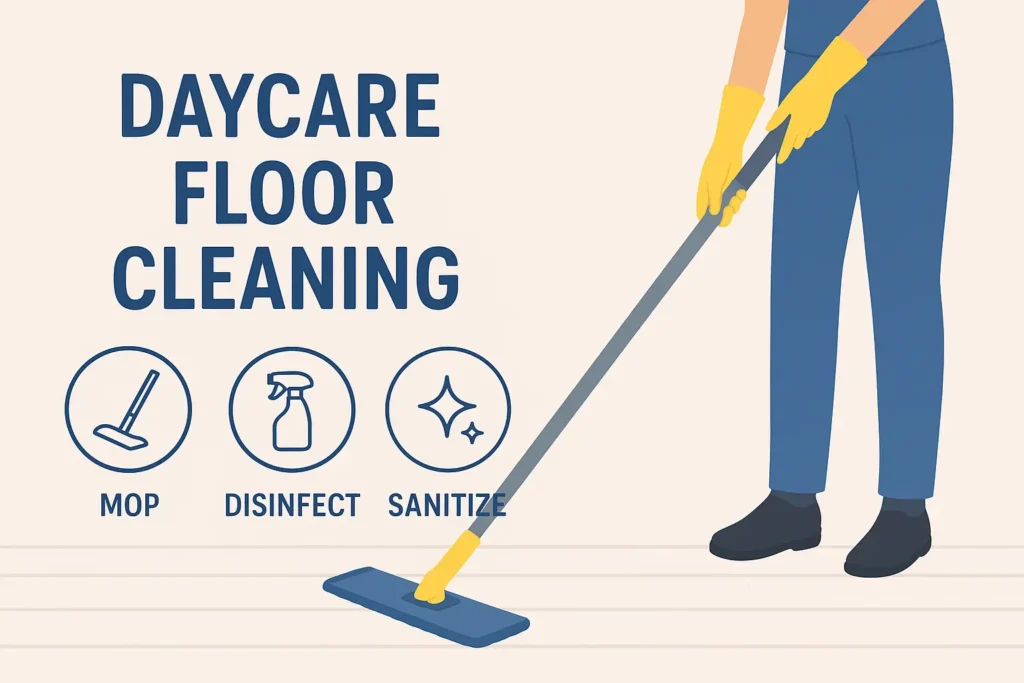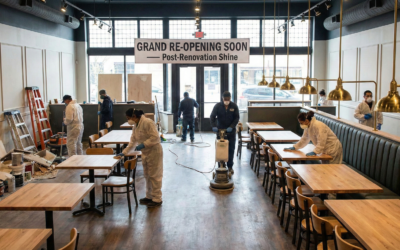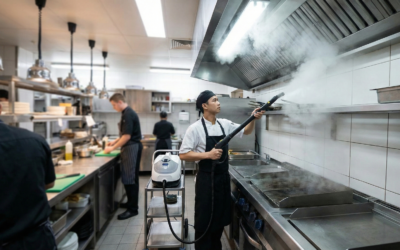Picture this: It’s 8 AM, and twenty energetic toddlers are about to storm through your daycare doors. Yesterday’s finger paint masterpiece is still decorating the tile near the art station, there’s mystery goop under the lunch table, and… is that crayon wax ground into the carpet corner?
If you’re nodding along, you’re not alone. Maintaining clean daycare floors isn’t just about appearance—it’s about creating a healthy environment where children can crawl, play, and explore safely. But here’s the kicker: not all floor cleaning methods are created equal, especially when little ones are involved.
Why Daycare Floor Cleaning Requires Special Attention
Daycare facilities face unique cleaning challenges that regular offices or homes don’t encounter. Children spend significant time on floors—crawling, sitting, playing, and yes… putting things in their mouths that have touched those surfaces.
The stakes are higher because young immune systems can’t fight off germs like adult systems can. Plus, you’re dealing with multiple floor types: vinyl tiles in classrooms, carpeted reading areas, rubber mats in play zones, and sometimes hardwood in common areas. Each material demands specific care.
Here’s what makes daycare cleaning different: you need products that are tough on germs but gentle enough for spaces where children play. Traditional harsh chemicals? They’re off the table when toddlers might lick the floor (and yes, they will).
Essential Daycare Floor Cleaning Supplies
Child-Safe Cleaning Products
Start with EPA-approved disinfectants that are safe for use around children. Look for products with the EPA’s Design for the Environment label. These solutions kill 99.9% of germs without leaving harmful residues.
Microfiber mops are your best friend—they trap dirt and bacteria more effectively than traditional cotton mops. You’ll want separate mops for different areas to prevent cross-contamination between bathrooms and classrooms.
Don’t forget pH-neutral cleaners for daily maintenance. They’re gentle on floor finishes while still removing everyday dirt and spills. Enzymatic cleaners work wonders on organic messes (think spilled milk or juice).
Must-Have Equipment
A quality wet vacuum saves hours of work, especially in areas prone to spills. Commercial-grade machines handle both wet messes and deep carpet cleaning when needed.
Microfiber cloths in different colors help maintain a color-coding system—blue for general surfaces, red for bathrooms, yellow for food areas. This simple system prevents spreading germs from one area to another.
Steam mops offer chemical-free sanitizing for hard surfaces. The high heat kills bacteria and viruses naturally, making them perfect for daycare environments.

Daily Daycare Floor Cleaning Routine
Morning Prep (15 minutes)
Before children arrive, do a quick sweep or vacuum of high-traffic areas. Focus on entryways where outdoor dirt accumulates and eating areas where yesterday’s snacks might be hiding.
Spot-clean any visible stains immediately—dried spills become exponentially harder to remove once little feet have tracked over them all day. A simple solution of warm water and mild dish soap handles most fresh messes.
Check for safety hazards like loose carpet edges or slippery spots. Um, there’s nothing worse than a child slipping because you missed a juice spill from yesterday.
Throughout the Day
Clean spills immediately—this can’t be stressed enough. Keep cleaning supplies accessible but secure. A rolling cart with child-proof locks works perfectly for quick response to messes.
After meal times, sweep and mop eating areas thoroughly. Food particles attract pests and create slip hazards when ground into floors.
Sanitize high-touch floor areas like doorway thresholds and spaces around sinks. These spots see constant traffic and moisture, making them bacteria hotspots.
End-of-Day Deep Clean (30-45 minutes)
Start with a thorough vacuum or sweep of all areas. Move lightweight furniture to clean underneath—you’d be amazed what accumulates under that reading corner chair.
Mop all hard surfaces with your approved disinfectant. Work from cleanest areas to dirtiest, typically starting with classrooms and ending with bathrooms and diaper-changing areas.
Allow adequate drying time. Proper air circulation prevents moisture buildup that can lead to mold or mildew issues.
Deep Cleaning Weekly Tasks
Carpet Care
Professional carpet cleaning every 3-6 months keeps carpeted areas healthy, but weekly maintenance is crucial. Vacuum thoroughly, including edges and corners where dirt accumulates.
Treat stains immediately with enzymatic cleaners designed for organic matter. These break down proteins in spills rather than just masking odors.
Steam cleaning monthly helps eliminate embedded dirt and allergens. If you don’t own a steam cleaner, renting one monthly is cost-effective for most small daycares.
Hard Surface Restoration
Strip and refinish floor wax quarterly to maintain that protective barrier. This process removes built-up dirt and grime while restoring the floor’s appearance.
Deep clean grout lines using a mixture of baking soda and water. Scrub with an old toothbrush, then rinse thoroughly. Sealed grout resists stains and bacteria buildup.
Buff floors monthly to restore shine and remove scuff marks from little shoes and toy wheels.
Safety Considerations When Cleaning
Never mix cleaning chemicals—ever. Even child-safe products can create dangerous fumes when combined. Store all products in original containers with clear labels.
Ensure adequate ventilation during cleaning. Open windows when weather permits, or run fans to circulate fresh air. Children are more sensitive to chemical fumes than adults.
Post wet floor signs and block off areas during cleaning. But wait… here’s something most people don’t consider: create a designated “clean zone” where children can safely wait while floors dry.
Use non-slip cleaning solutions. Some disinfectants leave residues that become slippery when wet, creating fall hazards for running children.
Common Daycare Floor Cleaning Challenges
Sticky Situations
Juice spills, finger paint, and snack remnants create sticky messes that attract more dirt. The key? Clean while they’re still wet. Once dried, these substances require special attention.
For dried sticky messes, apply warm water and let it sit for several minutes to soften the residue. Scrape gently with a plastic scraper, then clean with your regular floor solution.
Crayon and Marker Marks
Crayons melt into floor textures, especially in warm rooms. Ice cubes harden the wax, making it easier to scrape off. Follow up with a degreasing agent to remove oily residues.
Washable markers usually respond to simple soap and water, but permanent markers require rubbing alcohol. Test any solvent in an inconspicuous area first.
High-Traffic Wear Patterns
Entryways and pathways between popular play areas show wear quickly. Protective mats help, but regular deep cleaning prevents permanent damage.
Rotate furniture occasionally to distribute traffic patterns. Even small changes in room layout can significantly extend floor life.
Choosing the Right Cleaning Schedule
Small daycares might manage with daily cleaning and weekly deep tasks, while larger facilities need more frequent attention. Consider your enrollment, space size, and children’s ages when planning.
Infant rooms require more frequent daycare floor cleaning due to crawling and mouthing behaviors. Toddler areas need immediate spill response but less intensive daily care.
Create a cleaning checklist that staff can follow consistently. Consistency prevents small problems from becoming major issues.
Budget-Friendly Cleaning Solutions
You don’t need expensive specialized products for every task. White vinegar mixed with water creates an effective, child-safe cleaner for daily use. Baking soda tackles odors and mild stains naturally.
Buy cleaning supplies in bulk to reduce costs, but ensure proper storage to maintain effectiveness. Some products lose potency over time or in extreme temperatures.
Consider making your own enzymatic cleaners using natural ingredients. These work well for organic spills and cost significantly less than commercial versions.
FAQs
How often should daycare floors be professionally cleaned?
Hard floors should be professionally deep cleaned every 3-4 months, while carpets need professional attention every 6 months or more frequently in high-use areas.
What’s the safest disinfectant for floors where children play?
Look for EPA-registered products with the Design for the Environment label. Hydrogen peroxide-based cleaners are effective and break down into harmless water and oxygen.
Can I use bleach solutions on daycare floor cleaning?
Only use bleach solutions specifically designed for childcare facilities, and never in areas where children are present. Always rinse thoroughly and ensure complete drying before allowing children back into the space.
How do I remove permanent stains from daycare floors?
Most permanent-looking stains respond to patience and the right approach. Try enzymatic cleaners for organic stains, rubbing alcohol for ink, and specialized commercial stain removers for other issues.
What’s the best way to clean floors during operating hours?
Focus on immediate spill cleanup and spot cleaning during operating hours. Save thorough mopping for nap times or after hours when children aren’t present.
The Bottom Line
Maintaining clean daycare floors isn’t just about aesthetics—it’s about creating a healthy environment where children can explore, learn, and play safely. The investment in proper cleaning supplies and techniques pays dividends in reduced illness, fewer accidents, and happier families who trust you with their most precious possessions.
Start with the basics: child-safe products, consistent daily routines, and immediate attention to spills. Build from there with weekly deep cleaning and quarterly professional maintenance. Your floors—and the children who play on them—will thank you.
Remember, you’re not just cleaning floors; you’re maintaining a foundation for childhood development and discovery. Make it count.





